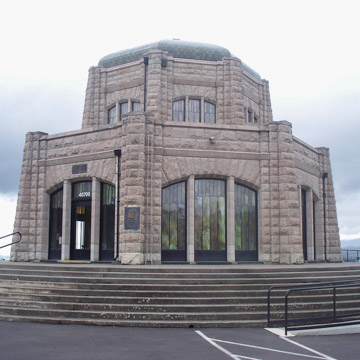This observation pavilion is located in one of Oregon’s most sublime landscapes, high atop the cliffs on Crown Point overlooking the scenic Columbia Gorge. It serves as a rest stop for travelers on the Columbia River Highway, the first planned scenic roadway in the United States. A few calculating minds originally had much more profitable ideas as how to exploit Crown Point, including the construction of coffee shops and service stations, or a 1915 scheme for a large hotel with an aerial tram to carry guests up from the river. However, civic leaders such as lumber barons Simon Benson and John Baptiste Yeon, along with highway engineer Samuel Lancaster, believed this the perfect place for “an observatory from which the view both up and down the Columbia could be viewed in silent communion with the infinite.” It was Lancaster who suggested the name “Vista House,” which would also serve as a comfort station.
On October 23, 1915, fifty-two prominent businessmen and civic leaders formed the Vista House Association to promote and oversee construction, with Henry L. Pittock, publisher of The Oregonian, as president. Construction began in late 1916. Yeon volunteered to serve gratis as roadmaster (construction supervisor) of the highway, while Edgar Lazarus of Portland was appointed architect. Some Portland area residents questioned the use of public funds for a structure they did not feel was necessary. Lazarus, however, who had studied at the Ecole des Beaux Arts, shared many of Lancaster’s sentiments about the Gorge, and his octagonal design reflects his Beaux-Arts training but also the influence of European styles including the Romanesque and the contemporaneous German Jugendstil.
Both new and old techniques were used in the construction of the building. The underlying structure is of reinforced concrete, faced on the exterior with coursed quarry-faced ashlar Tenino sandstone. The domed roof was originally covered with ornamental green-glazed tiles. The windows incorporate stained glass. The interior walls are faced with Kasota limestone with plaster and marble ornamentation. The floor is of multi-colored marble, while the interior of the dome and ribs were painted to simulate marble and bronze. At the suggestion of Lancaster, the Gorge’s indigenous inhabitants were represented by eight faces depicted at the base of each rib. Eight plaster panels, containing the names of pioneers, are embellished with plant forms recalling those found in the Gorge; paintings of early Oregon settlements hang between the windows.
Vista House quickly became a popular stop along the highway. The Oregon State Highway Commission took over the deed in 1938. During World War II, the building was closed and sustained extensive weather damage; subsequent repairs included replacing the green tile roof with copper. Oregon State Parks took possession of the structure in 1952. Water infiltration has been a persistent problem at Vista House, due to its elevation and its exposure to high winds and freezing temperatures. In 2000–2006, the facility was closed for a $4 million restoration, which also included the addition of an elevator to access the lower-level restrooms. Vista House continues to serve as a popular waystation along the scenic highway and the dramatic panoramic views have been preserved since 1986 as the Columbia Gorge National Scenic Area.










